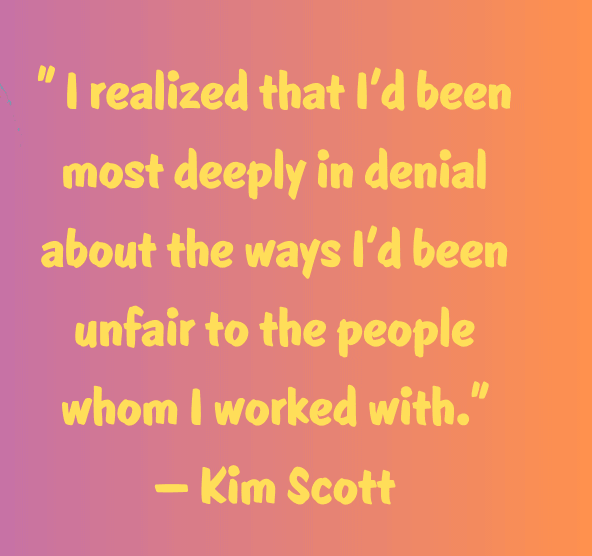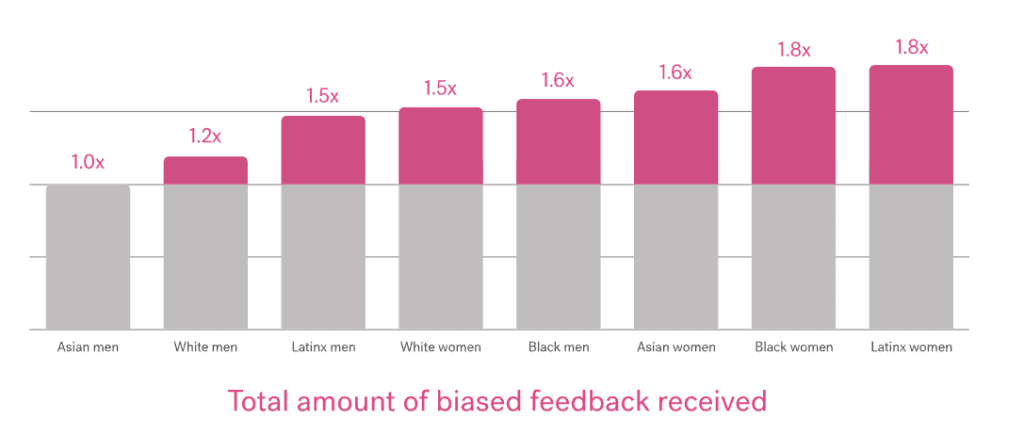Kim Scott is the author of Radical Candor: Be a Kick-Ass Boss Without Losing Your Humanity and Radical…
How to Overcome Protective Hesitation So EVERYONE Gets the Feedback They Deserve to Learn and Grow
Shortly after she published Radical Candor, Kim Scott realized that biased feedback and protective hesitation make giving and receiving guidance more difficult for underrepresented employees.
A former colleague had asked her to give a talk at her company about the book. When Scott finished the presentation, the woman pulled her aside and said:
“I’m excited to roll out Radical Candor here, Kim. I think it’s going to help me build the kind of innovative culture I want. But I gotta tell you. It’s a lot harder for me to roll it out than it is for you. As soon as I give anyone even the most gentle, compassionate criticism, I get slimed with the angry Black woman stereotype.”
This made Scott confront some hard truths.

“I realized that not only had I been in denial about the things that were happening to this person as a Black woman in the workplace, I had also been in denial about the things that had happened to me as a white woman in the workplace. I had never wanted to think of myself as a victim, so I pretended that a whole host of things were not happening to me that were in fact happening. Kind of hard for the author of a book about candor to admit, but there it was,” Scott notes when explaining what prompted her to write her follow-up book Radical Respect.
“Of course, even less than wanting to think of myself as a victim did I want to think of myself as a culprit. I realized that I’d been most deeply in denial about the ways I’d been unfair to the people who I worked with,” she continues.
“Ibram X Kendi said that denial is the heartbeat of racism. It’s also the heartbeat of sexism, homophobia, and all the other forms of intolerance that make collaboration and respect so difficult to achieve.”
This situation is not unique. Research has shown that underrepresented employees consistently receive low quality and biased feedback. High quality feedback can quite literally alter the trajectory of one’s career. Thus, adopting approaches and strategies to ensure workplace leaders are providing effective feedback to every employee is critical to organizational and employee success.
A study from the real-time bias-busting software company Textio found that employees who are most underrepresented in corporate leadership also receive inadequate or poor feedback. For example, Black and Latinx women receive 1.8x more biased feedback than Asian men, the group least likely to receive such feedback. The study also reported that female leaders are more likely to be described as “abrasive,” and Black women are more likely to be called “overachievers.”

Get Textio's 2023 Language Bias In Performance Feedback Report >>
Identifying Biased Feedback & Protective Hesitation
Radically candid feedback that is kind, clear, specific and sincere is vital to an employee’s growth. It keeps expectations clear, helping people understand what they’re doing well and where they can improve.
“A clear explanation of expectations, reassurances that an employee can meet those expectations, and guidance when a candidate falls short are crucial in helping everyone do their best work, but especially people who are underrepresented,” Scott explains.
So, if feedback is so essential, why do some leaders struggle to provide it to particular individuals? It’s still the case that the majority of managers are white and/or male. Scott explains that some fear their feedback will be interpreted in the wrong way, as racist, misogynistic or otherwise problematic.
When we withhold feedback, it’s more often about us, not the person who needs it. We might feel awkward, unsure of how we’ll be perceived, anxious, or uncomfortable if we don’t think the other person will take it well. The tendency to withhold difficult feedback from people who are different from us is called protective hesitation.
“It’s easier to give feedback to people who are like you or with whom you have a relationship,” says Jackye Clayton, vice president of talent acquisition and diversity, equity, inclusion and belonging at Textio and co-host with Scott and Kieran Snyder on the Real as Feedback Podcast.
“But then there are the times you feel like you shouldn’t necessarily give feedback because the person’s experiences are very different from yours.”
Despite this, feedback is an essential component in underrepresented people’s ability to overcome the additional challenges they face in the workplace, Scott explains.
In order to create a diverse and happy work environment, employers need to commit themselves to offering effective feedback to their employees, especially those of underrepresented identities. Here are five tips for how to do that most effectively.
1. Beware of the Fundamental Attribution Error
One common mistake that workplace leaders often make is using their own experiences to draw conclusions about the reasons for a person’s performance, according to Dr. Crystal Bedley, senior director at the Rutgers University Tyler Clementi Center for Diversity Education and Bias Prevention.
“If you catch yourself thinking something like ‘I would never do that if I were in their shoes,’ take a moment to pause and see whether you need to better understand what the employee is experiencing,” Bedley recommends.
Caring personally — taking the time to ask employees what challenges they face and what they need to be successful — can aid you in avoiding this mistake. It’s also important to create an environment of psychological safety before giving feedback.
In Fast Company Scott and Amy Edmondson, author and novartis professor of leadership and management at Harvard Business School, write: “People feel psychologically safe when they know they can recover from their mistakes and help others do the same. There is nothing safe about wondering what other people really think or where you stand.”
Bedley suggests a relationship-based approach: If someone is repeatedly showing up late to work, for example, ask them about obstacles in their morning routine.
@xanharrisThe fundamental attribution error 🧠♬ original sound – Xander
The fundamental attribution error makes us more likely to use personality attributes to explain someone else’s behavior rather than considering our own behavior or situational factors that were probably the real cause of the behavior.
Once you’ve identified the problem, you can help brainstorm the solution, say, by offering to adjust their work schedule. By avoiding the trap of assuming that it was easy for them to get to work on time as it was for you, you’re able to arrive at a simple solution.
“Ultimately, work toward a mindset where your default assumption is that everyone’s life circumstances are different. They do not mirror my own. What works for me may not work for others,” Bedley says.
2. Check In With Yourself

Clayton emphasizes the importance of checking your own unconscious biases before offering feedback. “Unconscious bias will hit you completely out of the blue, and you’ll react instantly without a thought,” she says.
Reflecting on the feedback before you give it can help you identify unconscious bias. Clayton recommends asking yourself a question like: “Would I give this feedback to somebody else?”
If the answer is no, your feedback may be reflecting bias. If you know you have some conscious bias, checks with employees before delivery can help identify the bias.
Feedback should remain strictly related to work and the employee’s performance in the workplace — comments related to an employee’s personality, character, or outfit choice do not impact their ability to do their job, and thus are not warranted.
Clayton says that identifying specific examples of the helpful criticism you’re giving can help confirm it’s not biased while also providing the employee with more direction on how they can improve.
At Radical Candor, this is called the CORE method. CORE — Context, Observation, Results, nExt stEps is an easy way to make sure feedback is focused and clear.
For example, here’s some helpful criticism that Scott received from her boss: “After the meeting when I told you that you said ‘um’ a lot and recommended a speech coach,” (context), “you made a brush-off gesture” (observation). “This makes me feel like you weren’t listening to me and won’t go to the speech coach I’m recommending, which would be a shame because if you stop saying um so much you’ll be more effective” (result). “Go to the speech coach! (nExt stEps)”
Above all, caring personally helps to ensure that feedback is not misrepresented.
“When you haven’t demonstrated care for those on your team, don’t routinely put the effort to show respect, don’t own your mistakes, and fail to value each team member for what they bring to the team, then critical feedback is often going to be interpreted negatively, and at worst will be viewed as sexist, racist, transphobic or homophobic,” Bedley says.
3. Be Kind, Clear, Specific & Sincere
Bedley and Clayton both encourage employers to ask employees for details about their preferences for receiving feedback, whether they prefer in person, Zoom or email. Matching their preferences is a way to be inclusive and respectful of contrasting needs.
Clayton encourages employers to avoid using vague language or language that presents the feedback as optional, such as “I think you may want to …” Avoiding this trap makes the feedback clear and accessible to everyone, particularly neurodivergent employees who may not pick up on the cues that are understood in conversation between neurotypical people.
Feedback should be accompanied by specific examples, and offered in a timely manner so that the person is able to remember and reflect on the incident that warranted the feedback.
“Something that’s really important to you may be minuscule to the person who’s getting the feedback,” Clayton says. “You want to make sure that they know what you’re talking about so that they can correct or make changes to their behavior or seek out additional help.”
4. Lay Your Power Down

Oftentimes, a boss’s intimidating title can get in the way of open conversation and comfort between them and an employee. Clayton finds that people are often hesitant to talk to her about DEI because they don’t want to make a mistake.
Taking the time to get to know employees, not only their career goals but also their personal goals, and aiding them in aligning those goals can help them see you in a more human light and aid in establishing trust.
Laying down your power by sharing your own experiences receiving and working on feedback also helps to close power gaps and make employees feel supported and open to feedback.
“People sometimes think that your ‘scary’ title makes you an expert on everything when in reality that’s far from the truth,” Clayton says. “Sharing your own experiences with feedback helps to change this mentality and make them feel validated.”
5. Foster Collaboration & Inclusion
Making an effort also goes beyond feedback. Role modeling inclusive language in all interactions goes a long way toward building trust. Bedley emphasizes that language shifts can go a long way: Leaders should try saying “you all” instead of “guys” and practice with they/them pronouns.
At the same time, ensure that your language does not treat everyone as belonging to a monolith. Your understanding that not everyone experiences the world, in the same way, can come through in your language choice: Bedley recommends “most people can understand …” instead of “everyone …”
“People from marginalized backgrounds do not come to see their supervisors as prejudiced because of how feedback is given, they are looking at all of their interactions with this supervisor,” Bedley said. “Making sure you are always demonstrating care and respect goes a long way.”
————————————————————————————————————————————————————————————–
Need help practicing Radical Candor? Then you need The Feedback Loop (think Groundhog Day meets The Office), a 5-episode workplace comedy series starring David Alan Grier that brings to life Radical Candor’s simple framework for navigating candid conversations.
You’ll get an hour of hilarious content about a team whose feedback fails are costing them business; improv-inspired exercises to teach everyone the skills they need to work better together, and after-episode action plans you can put into practice immediately to up your helpful feedback EQ.
We’re offering Radical Candor readers 10% off the self-paced e-course. Follow this link and enter the promo code FEEDBACK at checkout.



